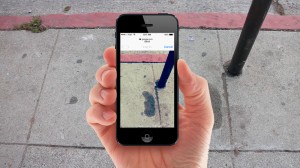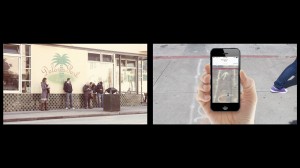Press Images
Please credit all images as "courtesy of the artist."
Simulations



Low Res | High Res Low Res | High Res Low Res | High Res
(video simulations available upon request)
Gallery Installation
two-channel projection, 01:40 (looped)
Press Release
FOR IMMEDIATE RELEASE
Contact:
Harris David Harris
(510) 343-6065
harris@harrisdavidharris.com
Art Installation Mimics and Disrupts Google Buses’ Wifi
San Francisco—A new media art installation entitled “d0ntb33vil” by local artist Harris David Harris, 30, exploits a loophole in wireless networking technology and joins the chorus of protests targeting Silicon Valley’s private tech shuttles. The piece aims to not only critique the shuttles’ impact on housing and transportation, but also suggests that personal technologies developed by companies like Google, Facebook, and Apple contribute to a growing disinvestment in the vitality of local communities and a sense of public good.
The intervention, which can be found at nine shuttle stops throughout San Francisco, is made up of wireless routers that broadcast names and passwords that mimic the companies’ own wireless networks, including Google’s “GBUS” and Facebook’s “fbshuttle”. (The title “d0ntb33vil” is the password to Google’s on-board wifi, based on its infamous corporate slogan, which the artist acquired through a simple Google search.) Because the identifiers match the shuttles’ credentials, devices that are set to “remember” known networks automatically connect to the installation’s routers while riders wait for their bus. The routers are not connected to the Internet; they instead use custom software and a built-in server to redirect and restrict users to a custom website that contains an animated image of the sidewalk that approximates the position and angle of their phones shot at each location (images available at link below). The routers do not collect any user data.
Harris describes the piece as a “conceptual intervention,” noting that the choice of imagery is both abstract and specific: “On the one hand, confronting riders with an image of the sidewalk offers an indeterminate symbol of failure, suggesting that something in their highly-customized interface has gone wrong, while not saying exactly what or why. On the other hand, the imagery gestures toward riders immediate surroundings and the consequences of increasingly experiencing our environments and social interactions through virtual means.”
However, Harris also contends that the piece is not necessarily intended to influence riders, but rather targets the corporate tech sector itself: “Though individuals may play a role in gentrification, it is ultimately a structural issue tied to government neglect and the increasing power of the unregulated market. Just as the shuttles offer a local example in the privatization of public transit, the sectors’ myriad apps and devices promote an increasingly consumer-oriented world in which citizens are nothing more than users, and the only sense of a shared “commons” can be found in paid or data-mined networks.” He added, “I’m not trying to reject the value of technology, but only to suggest that as a society, we should demand greater accountability and preserve equal access to housing and technology alike.”
“d0ntb33vil” serves as Harris’s MFA thesis project in the Digital Arts and New Media program at UC Santa Cruz.
FOR PRESS: Images and artist info available at: harrisdavidharris.com/d0ntb33vil. Installation may be viewed in person at 18th St at Dolores Google stop (SE corner, Muni stop next to Dolores Park Café); connect to network “GBUS” with password “d0ntb33vil.”
-###-
